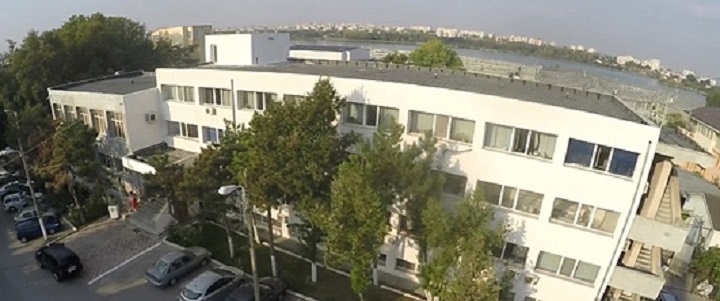|
National Institute for Marine Research and Development "Grigore Antipa"
|

|
|
Type of Research Institution
|
| | Intergovernmental | | | Academic | |  | Governmental, national | | | Private | | | Governmental, local | | | Charity / Foundation |
|
|
|
Address : Mamaia 300 Blv.
900581 Constanta
ROMANIA |
|
Phone :
+40 241 543 288
|
|
|
|
Director :
Dr Valeria Abaza
|
|
Contact person :
|
|
|
|
|
Number of permanent staff
|
| | Scientists (with doctorate/ PhD) : 49 | | | others : 44 |
|
|
|
Type of Activities
|
|  | Pure research | | | Academic | |  | Applied research | |  | Education / Outreach | |  | Long-term monitoring | |  | Policy / Planning / Consultancy | |  | Technology for environmental applications | |  | Conservation & Protection |
|
|
|
Main fields of research (at present - 6 max)
|
| marine and coastal ecology, systematics and taxonomy, living resources (e.g. fisheries, aquaculture), water quality and pollution, physical oceanography, coastal processes |
|
|
|
Main research collaborations at international level (at present)
|
| * research collaborations within joint research programs such as Framework Programmes of EC (H2020), ERANET, DG MARE, DG ENV, EASME/EMFF, Erasmus+, ESA, JOP CBS, etc. |
|
|
|
Ongoing long-term monitoring programs
|
| * NIMRD is the national operator of the National Integrated Monitoring System for marine area; it has the national scientific responsibility for the implementation of Marine Strategy Framework Directive and national scientific responsibilities for fisheries data collection and assessment of living resources |
|
|
|
Total area dedicated to research (m2)
|
|
|
|
|
Conference room
|
| no |  | yes (number of seats : 130 ) |
|
|
|
Research vessel(s)
|
| less than 12 m in length; number of vessels : 0 |  | more than 12 m in length; number of vessels : 1 | | Brief description of vessels and on board scientific equipment :
STEAUA DE MARE 1: 25.8 M length, 134 tons, 12m2, equipped for water and sediment (with biota) sampling |
|
|
|
Other major research facilities and equipment
|
* International level research facilities for: marine microbiology, molecular biology, phytoplankton, zooplankton, zoobenthos, marine macroalgae and angiosperms, marine habitats’ mapping, marine biochemistry, marine aquaculture, marine ichthyology, ecotoxicology, laboratory for nutrient analysis and chemical pollutants, physical operational oceanography, morphodynamics, bathymetry, GIS, noise, sea level monitoring station and tsunami warning, oceanographic station for real-time monitoring of physical parameters and quality of marine waters in the area of tourist interest (Mamaia Bay)
*
Experimental laboratory with basins in recirculating system
*
Maregraph network along the Romanian coast (Sulina, Midia, Constanta, Tomis Marina, Mangalia)
*
Fishing boat for scientific purpose “TETHYS” (7,8 m /1974 HP)
*
Boat RIB Mercury (4,2 m /30 HP) Diving team with specific facilities and underwater TV-system
*
Aerial and underwater drones, side scan sonar, ROVs etc. |
|
|
|
Ecosystem types available nearby
|
 | Direct access to sea | | No direct access to brackish / estuarine waters | |
Other ecosystems : Marine and brackish ecosystems, Danube Delta, coastal ecosystems |
|
|
|
Areas of taxonomic expertise
|
| phytoplankton, phytobenthos, zooplankton, zoobenthos, ichtyofauna, marine mammals |
|
|
|
Specimen collections
|
 | yes | | no | |
Brief description :
* Ichthyological collection (670 specimens) by the joint efforts of researchers and technicians aboard the ocean fishing vessels, mainly during 1970-1989. The Romanian fishing fleet, established in 1964, covered survey fisheries and, consequently, national halieutic research in the northern area and along the African coasts of the Atlantic, sporadically in the east-African zone of the western Indian Ocean. The most significant research actions aboard survey fishing vessels were made in the eastern central Atlantic.
* Collection of otoliths of over 5000 specimens of different lengths, weight and sex belonging to 10 fish species mostly commercial, sampled between 2012-2022 from the Black Sea.
* Macroalgae and marine phanerogams collection of over 300 specimens as herbarium sheets. The collection includes hundreds of specimens collected starting from 1920ies until 1970ies in the Black Sea and other seas, completed with recent ones. More than 100 years ago (1905-1906), the algologist Maria Celan collected specimens of macroalgae from the Adriatic Sea. All these specimens are in the possession of NIMRD.
* Shellfish collection – shells belonging to 109 species of both bivalves and gastropods collected from the Black Sea and Mediterranean
|
|
|
|
Hosting facilities for visiting scientists
|
| yes |  | no |
|
|
|
Training courses
|
 | yes | | no | |
demonstrative training on small scale shellfish farming key aspects organised once a year starting from 2019 with the support of FAO-GFCM |
|
|
|
Capacity and brief description of library
|
| library with more than 43,500 books
|
|
|
 CIESM GUIDE OF COASTAL INSTITUTES IN THE MEDITERRANEAN AND ADJACENT SEAS CIESM GUIDE OF COASTAL INSTITUTES IN THE MEDITERRANEAN AND ADJACENT SEAS
Last update : 01/02/2023
|

 CIESM GUIDE OF COASTAL INSTITUTES IN THE MEDITERRANEAN AND ADJACENT SEAS
CIESM GUIDE OF COASTAL INSTITUTES IN THE MEDITERRANEAN AND ADJACENT SEAS


